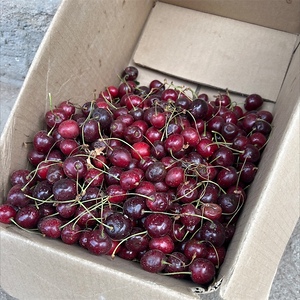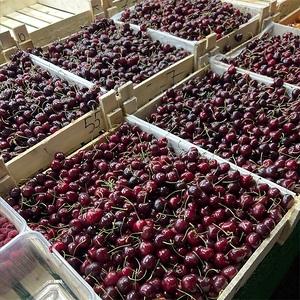


Cocon-Gilas Cherries
Estimated Inventory, lb : 0
Description/Taste
Cocon-Gilas cherries are a large varietal with a uniform, cordate, round, to slightly oval shape. The fruits are topped with slender, elongated, and pliable stems, often showcasing shades of pale green to brown. These stems are signs of freshness when kept attached and sold with the fruits. The cherry’s skin is smooth, taut, thin, and glossy, ripening to shades of burgundy, crimson, and dark purple, almost black. The skin is delicate and easily punctured or bruised, resulting in each cherry needing to be hand-picked and inspected before sale. Underneath the surface, the flesh exhibits variegated hues of pale red, dark red, and pink-white and is semi-firm and crisp with an aqueous, succulent, and tender mouthfeel. The flesh also encases a central, light brown stone that should be discarded during consumption. Cocon-Gilas cherries emit a faintly sweet and tangy aroma, and the fruits are consumed raw when ripe, releasing a pleasant, sweet-tart, fruity taste.
Seasons/Availability
Cocon-Gilas cherries are available in the late spring through mid-summer.
Current Facts
Cocon-Gilas cherries, botanically a part of the Prunus genus, are a specialty variety grown in Kyrgyzstan, belonging to the Rosaceae family. The fruits grow on deciduous trees reaching 12 meters in height, and depending on the region and tree, the variety typically produces fruit approximately 3 to 5 years after planting. Cocon-Gilas cherries are a popular variety cultivated in Southern Kyrgyzstan for commercial sale and as a home garden tree. Each tree can produce around 20 to 25 kilograms of fruit per season, and the trees are drought-resistant and hardy. Cocon-Gilas cherries are a seasonal delicacy throughout Kyrgyzstan, and the fruits are valued for their large size, succulent texture, and sweet-tart flavor. When the cherries arrive in markets, the fruits are purchased for culinary use, complementing sweet or savory preparations, and they are also bought as gifts and souvenirs in their growing regions.
Nutritional Value
Cocon-Gilas cherries are a source of vitamin C to strengthen the immune system, calcium to build strong bones and teeth, vitamin E to protect the cells against damage caused by free radicals, and vitamin A to maintain healthy organs. The fruits also provide potassium to balance fluid levels within the body, magnesium to control nerve functions, antioxidants to reduce inflammation and protect the body's overall health, and other nutrients, including B vitamins, folate, iron, copper, phosphorus, and zinc.
Applications
Cocon-Gilas cherries have a sweet-tart taste suited for fresh or cooked preparations. The variety can be used in any recipe, calling for common sweet cherries, which are popularly eaten out of hand as a snack or dessert. Cocon-Gilas cherries can be sliced and tossed into salads, mixed into fruit medleys, or served as a garnish over various breakfast dishes, main dishes, and desserts. The fruits are also commonly blended into juices, smoothies, and shakes. In Russia, cherries are notably juiced into kompot, a refreshing beverage made from seasonal fruits that can be consumed on hot days. In addition to fresh preparations, Cocon-Gilas cherries can be baked into bars, crumbles, cobblers, brownies, cakes, and galettes. The variety can also be blended and frozen into ice cream, sorbet, and popsicles. In Kyrgyzstan, cherries are traditionally simmered into jams, jellies, syrups, and sauces. The fruits are also fermented and made into alcoholic beverages. Beyond fresh uses, Cocon-Gilas cherries are dried for extended use. Dried cherries are known to have increased nutritional value and are mixed into rice dishes, salads, desserts, and other grain-based meals. Cocon-Gilas cherries pair well with other fruits such as blueberries, plums, raspberries, and citrus, cheeses including goat, camembert, and cheddar, spices such as anise, nutmeg, and cinnamon, and nuts including pecans, walnuts, almonds, and pistachios. Whole Cocon-Gilas cherries have a short shelf life and should be immediately consumed for the best quality and flavor. The fruits may last for a few days when stored in the refrigerator.
Ethnic/Cultural Info
Extensive cherry production in Kyrgyzstan began in the early 21st century and was developed from a need for additional sources of income. During this time, poverty across southern Kyrgyzstan led many to leave their homes and travel to Russia to look for work. This caused families to become separate and torn between two locations. Poverty in Southern Kyrgyzstan also led to the planting of more gardens to grow crops for food. As family gardens were built, some business-centric communities decided to become farmers as a trade to be able to remain local and keep their families together. Cherry trees were planted in orchards as they were considered easier to harvest and cultivate than other labor-intensive crops such as potatoes. Care for cherry trees is a year-round task, and Kyrgyz growers often partner with other growers in orchards to cultivate the trees. All members of families would also participate in the fruit harvest each season. Over time, cherry production became a large-scale business in Southern Kyrgyzstan, and the industry employs many to assist with cultivation, harvesting, packing, and exporting. In the modern day, Cocon-Gilas cherries are a signature souvenir or gift to bring back from Southern Kyrgyzstan regions, and the fruits have acquired a reputation of quality with exceptional taste.
Geography/History
Cocon-Gilas is native to Central Asia and has been commercially grown in the southern regions of Kyrgyzstan. The variety is considered a summertime symbol of Kyrgyzstan and is an anticipated seasonal crop. Much of the history of Cocon-Gilas’ origins is unknown, but some sources claim the variety was first grown in the village of Kashgar-Kyshtak, a rural community in the Kara-Suu District of the Osh Region. Other sources mention that the Kadamjay District in the Batken Region may have been the center of origin. Despite its murky roots, Cocon-Gilas was harvested in these regions in the early to mid-20th century and was transported and sold in Kokon, also known as Kokand, a city in the Fergana Region in Eastern Uzbekistan. Kokon is rumored to have inspired the name Cocon-Gilas, sometimes written as Kokon-Gilas after the city. Gilas is said to mean “cherry” in Kyrgyz. The Aravan District in the Osh Region of southwestern Kyrgyzstan is credited with being one of the first areas for full-scale cherry production, and soon after, several other regions also established a profitable cherry business. Today, Cocon-Gilas is commercially grown through family orchards in the Osh, Batken, Jalal-Abad, Chui, and Talas Regions. Within the Kadamjay District in the Batken region, Üch-Korgon is famous for its production and export of Cocon-Gilas. When in season, Cocon-Gilas is sold directly through growers, farmer’s markets, and select distributors. The fruits are also exported to Russia, China, and Kazakhstan. The Cocon-Gilas cherries featured in the photograph above were sourced through a street vegetable vendor in the village of Bulan Segetuu near Issyk Kul Region in Kyrgyzstan.









